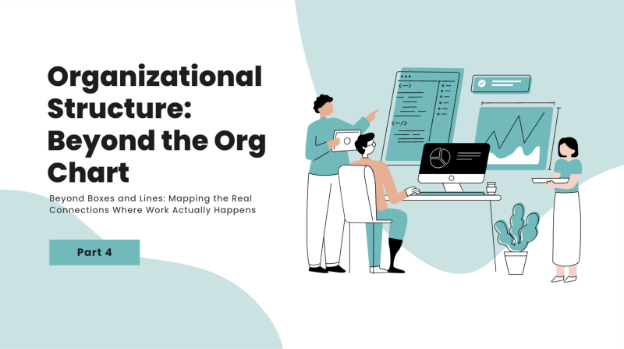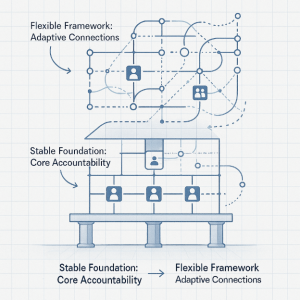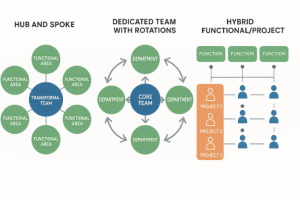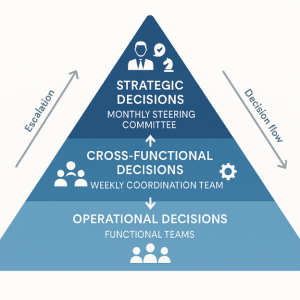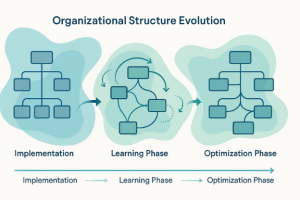In our previous posts, we explored strategy as your “why,” operating models as your “how,” and core functions as your “what.” Now let’s examine the fourth critical component of your governance blueprint: Organizational Structure—the framework that determines how information flows and decisions are made.
Beyond the Org Chart: Reality vs. Theory
Organization charts are like architectural drawings—they show the ideal structure, but they rarely capture how people actually move through the building.
The formal org chart provides a visual representation of how information should ideally flow, but reality is wonderfully messy. Your governance blueprint should embrace this messiness rather than pretend it doesn’t exist.
What Key Questions Does Organizational Structure Resolve?
Your organizational structure clarifies: How is the team arranged to facilitate optimal information flow?
This seemingly simple question has profound implications. The way you structure your transformation team determines:
- How quickly information travels
- Where bottlenecks are likely to form
- How decisions get made and communicated
- Where power and influence actually reside
Why Organizational Structure Matters: The Hidden Networks
The greatest challenge in organizational structure isn’t designing the formal hierarchy—it’s recognizing and leveraging the informal networks where work actually happens.
In many organizations, the formal org chart shows clean reporting lines between departments, but the reality of day-to-day operations is much more complex. Critical information often needs to flow horizontally across divisions, even when no formal reporting relationship exists.
These informal networks—the connections that develop organically as people work together to solve problems—often carry the most vital information and drive the most important decisions. When governance blueprints acknowledge and formalize these “dotted line” relationships, implementation speed typically increases dramatically.
The power of revising organizational structures to reflect reality rather than theory comes not from changing the formal hierarchy, but from legitimizing and supporting the conversations and collaborations that need to happen for success.
Building Flexible Structures: The Foundation and the Frame
The most effective organizational structures for transformation combine:
Stable Foundation
Core reporting relationships that provide clarity about ultimate accountability and decision rights.
Flexible Framework
Adaptable connections that can evolve as you learn more about what your transformation requires.
Your governance blueprint should embrace this duality by:
- Regularly Revisiting and Redrawing
Schedule regular reviews of your organizational structure to reflect emerging realities. Treat structure as a hypothesis to be tested against experience, not a declaration to be defended at all costs. - Creating “Dotted Lines”
Explicitly document and communicate the unofficial but critical relationships that make your transformation work. Give people permission to collaborate across formal boundaries. - Building Flexibility Within Clarity
Create enough structure to prevent chaos while maintaining enough flexibility to adapt as you learn. Define the non-negotiable elements of your structure while leaving room for teams to self-organize around specific challenges.
Figure 1: Stable Foundation with Flexible Framework
Common Structural Patterns in Transformation
Figure 2: Proven Organizational Patterns for Digital Transformation
While every organization is unique, several structural patterns have proven effective for digital transformations:
Hub and Spoke
A central transformation team (the hub) connects to designated representatives in each functional area (the spokes). This model balances centralized coordination with distributed expertise.
Dedicated Team with Rotations
A core team is supplemented by rotating members from different parts of the organization who join for specific phases. This approach builds broad organizational capability while maintaining continuity.
Hybrid Functional/Project Structure
Team members maintain their functional reporting relationships but dedicate specific time to transformation activities. This model works well when full-time dedication isn’t possible.
The right pattern depends on your specific context—your organization’s size, culture, transformation scope, and existing structures all influence which approach will work best.
Structure in Practice: The Case of Cross-Functional Decision Making
One of the most challenging aspects of transformation is cross-functional decision making. Your organizational structure must provide clear paths for decisions that cut across traditional silos.
Some transformations benefit from a tiered decision-making structure to manage complexity—especially in highly regulated or cross-functional environments like healthcare or finance:
- Operational decisions were made within functional teams
- Cross-functional decisions with limited scope were addressed by a weekly coordination team
- Strategic decisions affecting multiple departments went to a monthly steering committee
This structure provided clarity about where different types of decisions should be made, preventing both bottlenecks and fragmentation.
Figure 3: Tiered Decision-Making Framework for Complex Transformations
Organizational Structure as a Living Document
Remember that organizational structure in a transformation isn’t carved in stone—it’s drawn in sand at the water’s edge, meant to be refreshed as the tide of experience washes in.
The most successful transformations treat their organizational structures as living documents, regularly updated to reflect new insights, emerging challenges, and evolving relationships.
Figure 4: Organizational Structure as an Evolving Blueprint
Looking Ahead: The Next Blueprint Component
While organizational structure defines how your team is arranged, it doesn’t specify how decisions get made or issues get resolved. In our next post, we’ll explore the fifth and last critical component of your governance blueprint: Governance Framework.
We’ll examine how to create systems for decision-making, issue resolution, and accountability that keep your transformation moving forward—even when the path gets difficult.
____________________________________________________________________________________
This article is the fourth in our “Blueprint for Digital Transformation” series—a journey through the architecture of change that builds organizations ready for the digital future.
How has your organization’s formal structure helped or hindered transformation efforts? Have you found ways to leverage informal networks to accelerate change? Share your experiences in the comments below.
